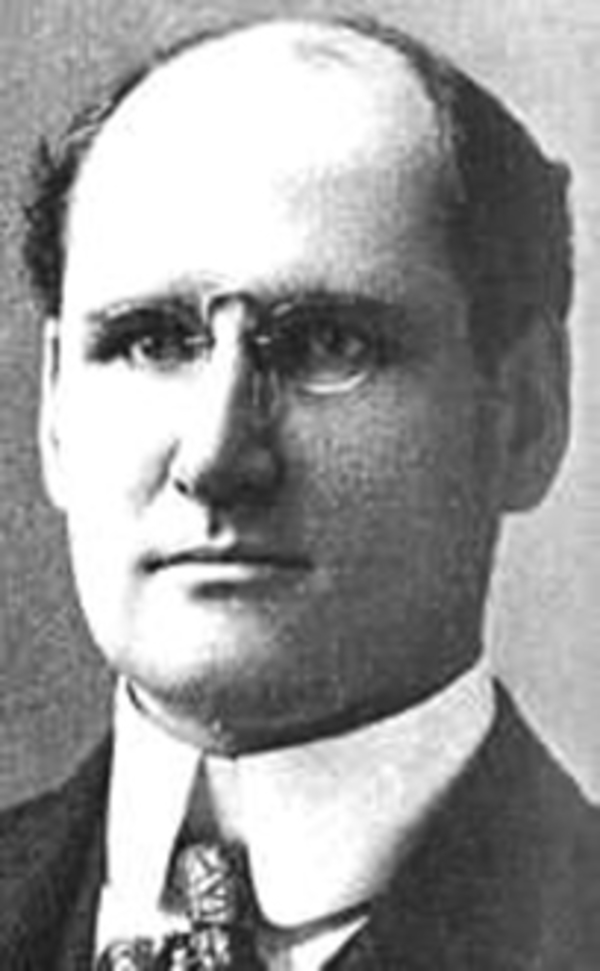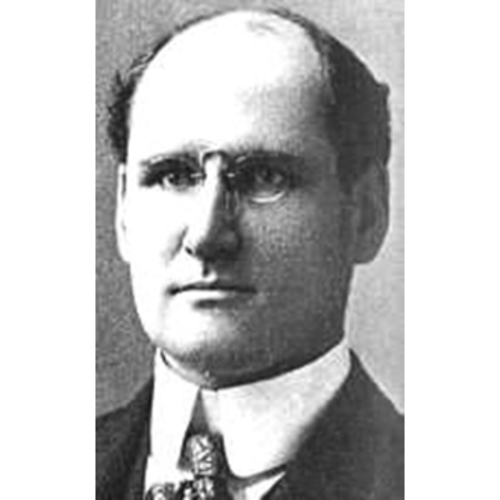
Source: Link
RYCKMAN, EDMOND BAIRD, lawyer, businessman, and politician; b. 15 April 1866 in Huntingdon, Lower Canada, son of the Reverend Edward Bradshaw Ryckman and Emmaline Edmond Baird; m. 30 Oct. 1895 Mabel Louise Gurney in Toronto, and they had four children; d. there 11 Jan. 1934 and was interred in the Mount Pleasant Mausoleum.
E. B. Ryckman’s paternal ancestors were United Empire Loyalists. Following the American revolution they relocated to Wentworth County in Upper Canada, settling near Hamilton. Young Edmond was named after his maternal grandfather, Edmond Baird*, a well-known Montreal cabinet-maker and upholsterer from Scotland. Soon after Edmond was born, his father, a prominent Methodist preacher and educator, moved the family to Kingston. They later lived in Guelph, where his schoolmates included John McCrae*, who would write the famous poem “In Flanders fields,” and Hugh Guthrie, a future cabinet colleague. Ryckman continued his education at the Brantford Collegiate Institute, where he excelled in academics as well as athletics, playing on three championship football teams. He graduated from Victoria College in Cobourg with a ba (1887) and an ma (1889), earning gold medals in classics and general proficiency. In 1890 he received another gold medal upon completion of his llb at Toronto’s Osgoode Hall law school. Ryckman set up a law practice in partnership with others in the city. Five years later, at the age of 29, he wed Mabel Louise, the daughter of the prominent stove-making industrialist Edward Gurney*, in a service conducted by his father in Metropolitan Church. The Ryckmans would have two sons, who were sent to a prestigious boarding school in England, and two daughters.
The firm of Ryckman, Kirkpatrick, Kerr and MacInnes, which was located in Toronto’s financial district, quickly achieved prominence in the field of commercial and corporate law. Among its clients were the Molsons Bank [see William Molson*] and the Accident Insurance Company of North America. The firm also represented the foundry operations owned by Ryckman’s father-in-law as well as Dunlop Tire and Rubber Goods, which had been established by Alfred Ernest Ames; Ryckman would for many years serve as a director of the former and president of the latter. By 1907 he had renamed his firm Ryckman, Kerr and MacInnes, and the following year the Conservative provincial government headed by James Pliny Whitney* appointed him a kc. A prominent force on Bay Street, Ryckman was a member of the Toronto, National, Albany, Hunt, and Royal Canadian Yacht clubs in his own city, the Manhattan Club in New York, the Rideau Club in Ottawa, and the Caledon Mountain Trout Club. He also belonged to the Orange lodge.
Ryckman had ventured into the world of corporate business as early as 1893, when he became one of the first investors in the National Automatic Vending Machine Company of Canada. About six years later he joined a syndicate of prominent Methodist businessmen, including Ames, Walter Edward Hart Massey*, George Albertus Cox*, and Joseph Wesley Flavelle, who acquired and merged five southern Ontario bicycle manufacturers. The Canada Cycle and Motor Company (CCM) became one of the country’s largest publicly subscribed enterprises and another of Ryckman’s prestigious clients. (Ryckman himself had been an ardent cyclist in his youth, joining enthusiasts such as Perry Ernest Doolittle as a member of the Toronto Bicycle Club and serving as its secretary for a time.) Under the direction of Thomas Alexander Russell, the business expanded successfully into automobile production. Ryckman was vice-president when the name was changed to the Russell Motor Car Company (and CCM made a subsidiary) in 1911 and when Russell turned over operations to munitions manufacturing during the First World War. Although Ryckman’s business interests thrived at this time, his family suffered a loss: his elder son, a second lieutenant in the British Royal Flying Corps, was killed in action in May 1916, and that autumn Ryckman travelled to France to visit the grave.
Ryckman’s political aspirations had become evident in 1894 when, at the age of 28, he was nominated by the Ontario Conservatives as their candidate in the riding of York East. Though defeated, he remained connected to the party, twice serving as treasurer of its provincial association in the early 1900s. In 1908 he declined an invitation to run in Toronto East for Robert Laird Borden’s federal Conservative Party. He did, however, maintain his back-room involvement through fund-raising, and in the 1920s he would help Premier George Howard Ferguson* obtain organizational financing for the Ontario Tories.
Following the war Ryckman became more than a party bagman. The electoral prospects in 1921 were grim for the Conservatives, now part of Arthur Meighen*’s National Liberal and Conservative Party, which was the successor to Borden’s wartime coalition, the Union government. Nonetheless, Ryckman accepted the nomination in Toronto East; the seat had become vacant following Sir Albert Edward Kemp*’s appointment to the senate. Ryckman put up a good fight against opponents from the Labour Party and the newly formed Progressive Party, an independent candidate, and a woman – a novelty for the era – representing William Lyon Mackenzie King*’s Liberals. Although he attracted only 36 per cent of the total ballots, in a five-cornered contest that was enough to ensure his victory. Subsequent wins in the 1925, 1926, and 1930 elections were more decisive; each time he captured over two-thirds of the vote in two-way races against a single Liberal opponent. As an mp he served on several House of Commons committees, including those concerned with banking and commerce, privileges and elections, and public accounts. When Meighen led the opposition (1922–26), he increasingly relied on Ryckman’s informed counsel, and during Meighen’s short-lived administration in 1926, Ryckman was appointed minister of public works.
Between 1927 and 1930 Ryckman was one of five wealthy benefactors – the others being lumber merchant Sir George Halsey Perley, B.C. businessman Alexander Duncan McRae*, manufacturer James Dew Chaplin, and Meighen’s successor as Conservative leader, Richard Bedford Bennett* – who personally financed the national party headquarters. In the late 1920s Ryckman subsidized the publication of the Port Hope Times, the only Tory daily between Belleville and Toronto. Its operating deficit cost him $500 per week. By 1927 he wanted to withdraw, but Ferguson and others persuaded him to keep it going. Two years later it folded. Leading up to the 1930 federal election, Ryckman, industrialist Robert Home Smith, and advertising-agency owner John Joseph Gibbons were put in charge of bringing in money for the party’s campaign in Ontario; when results fell short, the three underwrote the deficit.
When Bennett secured a Conservative majority in July 1930, he named Ryckman, aged 64, minister of national revenue. Ryckman resigned his corporate directorships, which by then included the International Business Machines Corporation (IBM) and the Addressograph International Corporation, whose ability to collate names and addresses by specific criteria had been indispensable to the Tories’ 1930 campaign. He was now, in essence, the nation’s tax collector, heading a department that gathered almost $400 million in annual revenue, mainly from customs and excise duties and from taxes on income, business profits, and sales. The Conservatives had promised to end unemployment by protecting the home market. Measures were passed in a special session of parliament in September, which saw Bennett and his minister of trade and commerce, Henry Herbert Stevens*, increase tariffs while Ryckman shored up regulations to protect against American dumping of cheap goods on the Canadian market. Ryckman did not accompany Bennett to London, England, for the Imperial Conference in October, but he did travel across Canada to consult with business interests. His was a complex and vital portfolio, requiring strong, sure-handed administration. In a Maclean’s magazine profile that had appeared shortly after Ryckman’s appointment, the journalist Michael Grattan O’Leary* lauded him for his “able, well-trained mind, wide experience of business and industry, [and] a complete intellectual integrity.”
Although Ryckman was trusted by the prime minister, his Bay Street background and patrician manners did not endear him to more populist Conservative colleagues such as Stevens, who described him as a “very typical big interest man.” An old-line Tory, Ryckman took an approach to the economic devastation of the Great Depression that leaned markedly towards belt tightening. This stance won him few friends and often turned allies into adversaries. A disappointed would-be contractor, Richard Ambrose Stapells of the J. J. Gibbons agency – which had earned $35,000 for handling advertising for the Conservatives’ 1930 campaign and whose owner was a prominent party man – wrote to Ferguson that “E. B. Ryckman was almost offensive in his attitude.”
The strain of public office took its toll on the minister’s health. Along with high blood pressure and hardening of the arteries, he began to suffer from chronic nephritis, a severe inflammation of the kidneys. Citing illness, he resigned his cabinet post on 30 Nov. 1933, to be succeeded by Robert Charles Matthews*. He died a little over a month later at his home at 44 Walmer Road in Toronto. Though his life ended short of the biblical three score and ten years familiar to him as a son of the Protestant manse, E. B. Ryckman had nonetheless scaled the heights of law, business, and politics.
There is no significant collection of Edmond Baird Ryckman’s private or public papers. For primary-source evidence of his political career, one must search the archival holdings of political colleagues, particularly the prime ministerial papers of Richard Bedford Bennett at the Univ. of N.B. Libraries, Arch. & Special Coll. in Fredericton (MG H 96) and of Arthur Meighen at LAC (R14423-0-6).
Ancestry.com, “New York, passenger lists, 1820–1957,” Edmond B. Ryckman: www.ancestry.ca (consulted 13 Feb. 2018). AO, RG 80-8-0-1474, no.001459. NA, Census returns of England and Wales, 1911, Eng., Surrey, Kew. Globe, 21 Jan. 1908, 12 Jan. 1934. Hamilton Spectator, 8 May 1916. Toronto Daily Star, 3 Oct. 1916. Canadian Almanac … (Toronto), 1910. Canadian directory of parl. (Johnson). The Canadian law list (Toronto), 1905. Canadian men and women of the time (Morgan; 1912). Commonwealth War Graves Commission, “Find war dead,” Edward Gurney Ryckman: www.cwgc.org/find/find-war-dead (consulted 14 Feb. 2018). Alvin Finkel, Business and social reform in the thirties (Toronto, 1979). L. A. Glassford, Reaction and reform: the politics of the Conservative Party under R. B. Bennett, 1927–1938 (Toronto, 1992). M. G. O’Leary, “Cabinet portraits,” Maclean’s, 15 Oct. 1930: 11, 85–86. P. B. Waite, In search of R. B. Bennett (Montreal and Kingston, Ont., 2012). Who’s who in Canada, 1932/33. [J.] R. [H.] Wilbur, H. H. Stevens, 1878–1973 (Toronto and Buffalo, N.Y., 1977).
Cite This Article
Larry A. Glassford, “RYCKMAN, EDWARD BAIRD,” in Dictionary of Canadian Biography, vol. 16, University of Toronto/Université Laval, 2003–, accessed December 31, 2025, https://www.biographi.ca/en/bio/ryckman_edmond_baird_16E.html.
The citation above shows the format for footnotes and endnotes according to the Chicago manual of style (16th edition). Information to be used in other citation formats:
| Permalink: | https://www.biographi.ca/en/bio/ryckman_edmond_baird_16E.html |
| Author of Article: | Larry A. Glassford |
| Title of Article: | RYCKMAN, EDWARD BAIRD |
| Publication Name: | Dictionary of Canadian Biography, vol. 16 |
| Publisher: | University of Toronto/Université Laval |
| Year of publication: | 2024 |
| Year of revision: | 2024 |
| Access Date: | December 31, 2025 |



